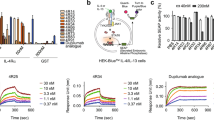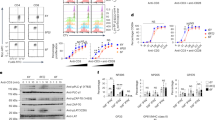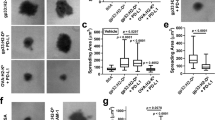Abstract
We have developed peptide analogs to analyze precise human CD4 substructures involved in MHC class II binding. Forms of the complementarity determining-like regions (CDRs) of the D1 domain of human CD4 were reproduced as synthetic aromatically modified exocyclic (AME) analogs and tested for their ability to block CD4-MHC II interactions and T cell activation. The exocyclic derived from CDRS (residues 82-89) of human CD4, which specifically associated with CD4 on the T cell surface to create a heteromeric CD4 complex, blocked IL-2 production and antagonized the normal function of the CD4 receptor. The approach of creating novel synthetic antagonistic receptor complexes may represent a new receptor specific pharmaceutical approach to modulate biological function.
This is a preview of subscription content, access via your institution
Access options
Subscribe to this journal
Receive 12 print issues and online access
$209.00 per year
only $17.42 per issue
Buy this article
- Purchase on Springer Link
- Instant access to full article PDF
Prices may be subject to local taxes which are calculated during checkout
Similar content being viewed by others
References
Gay, D., Maddon, P., Sekaly, R., Talle, M.A., Godfrey, M., Long, E. et al. 1987. Functional interaction between human T-cell protein CD4 and the major histo-compatibility complex HLA-DR antigen. Nature 328: 626–629.
Wang, J.H., Yan, Y.W., Garrett, T.P., Liu, J.H., Rodgers, D.W., et al. 1990. Atomic structure of a fragment of human CD4 containing two immunoglobulin-like domains. Nature 348: 411–418.
Ryu, S.E., Kwong, P.D., Truneh, A., Porter, T.G., Arthos, J., Rosenberg, M. et al. 1990. Crystal structure of an HIV-binding recombinant fragment of human CD4. Nature 348: 419–426.
Moebius, U., Pallai, P., Harrison, S.C., and Reinherz, E.L. 1993. Delineation of an extended surface contact area on human CD4 involved in MHC class II major histocompatibility complex binding. Proc. Natl. Acad. Sci. USA 90: 8259–8263.
Barber, E.K., Dasgupta, J.D., Schlossman, S.R., Trevillyan, J.M. and Rudd, C.E. 1989. The CD4 and CD8 antigens are coupled to a protein-tyrosine kinase (p56lck) that phosphorylates the CD3 complex. Proc. Natl. Acad. Sci. USA 86: 3277–3281.
Hussey, R.E., Richardson, N.E., Kowalski, M., Brown, N.R., Chang, H.-C., Siliciano, R.F. et al. 1988. A soluble CD4 protein selectively inhibits HIV replication and syncytium. Nature 331: 78–81.
Sakihama, T., Smolyar, A. and Reinherz, E.L. 1995. Oligomerization of CD4 is required for stable binding to class II major histocompatibility complex proteins but not for interaction with human immunodeficiency virus gp120. Proc. Natl. Acad. Sci. USA 92: 6444–6448.
Field, B., Ober, B., Malchiodi, E., Lebedeva, M., Braden, B., Ysern, X. et al. 1995. Crystal structure of the Vα domain of a T cell antigen receptor. Science 270: 1821–1824.
Konig, R., Shen, X. and Germain, R.N. 1995. Involvement of both major histocompatibility complex class II alpha and beta chains in CD4 function indicates a role for ordered oligomerization in T cell activation. J. Exp. Med. 182: 779–787.
Langedijk, J.P., Puijk, W.C., van, H.W., and Meloen, R.H. 1993. Location of CD4 dimerization site explains critical role of CDR3-like region in HIV-1 infection and T-cell activation and implies a model for complex of coreceptor-MHC. J. Biol. Chem. 268: 16875–16878.
Dougall, W.C. and Greene, M.I. 1994. Biological studies and potential therapeutic applications of monoclonal antibodies and small molecules reactive with the neulc-erbB-2 protein. Cell Biophysics 25: 209–218.
Saragovi, H.U., Fitzpatrick, D., Raktabutr, A., Nakanishi, H., Kahn, M. and Greene, M.I. 1991. Design and synthesis of a mimetic from an antibody complementarity-determining region. Science 253: 792–795.
Scheirle, A., Takacs, B., Kremer, L., Marin, F. and Sinigaglia, F. 1992. Peptide binding to soluble HLA-DR4 molecules produced by insect cells. J. Immunol. 149: 1994–1999.
Konig, R., Huang, L.Y. and Germain, R.N. 1992. MHC class II interaction with CD4 mediated by a region analogous to the MHC class I binding site for CD8. Nature 356: 796–798.
Cammarota, G., Scheirle, A., Takacs, B., Doran, D.M., Knorr, R., Bannwarth, W., Guardiola, J. et al. 1992. Identification of a CD4 binding site on the beta 2 domain of HLA-DR molecules. Nature 356: 799–801.
Piatier-Tonneau, D., Gastinel, L.N., Amblard, R., Wojcik, M., Vaigot, P. and Auffray, C. 1991. Interaction of CD4 with HLA class II antigens and HIV gp120. Immunogenetics 34: 121–128.
Marrack, P., Endres, R., Shimonkevitz, R., Zlotnik, A., Dialynas, D., Fitch, R. and Kappler, J. 1983. The major histocompatibility complex-restricted antigen receptor on T cells. II. Role of the L3T4 product. J. Exp. Med. 158: 1077–91.
Jameson, B.A., McDonnell, J.M., Marini, J.C. and Korngold, R. 1994. A rationally designed CD4 analogue inhibits experimental allergic encephalo-myletis. Nature 368: 744–746.
Habeeb, F.F. 1973. A sensitive method for localization of disulfide containing peptides in column effluents. Anal. Bioch. 56: 60–65.
Ponder, J.W. and Richards, F.M. 1987. Tertiary templates for proteins. Use of packing criteria in the enumeration of allowed sequences for different structural classes. J. Mol. Biol. 193: 775–791.
Shimonkevitz, R., Kappler, J., Marrack, P. and Grey, H. 1983. Antigen recognition by H-2-restricted T cells. I. Cell-free antigen processing. J. Exp. Med. 158: 303–316.
Sette, A., Sidney, J., Albertson, M., Miles, C., Colon, S.M., Pedrazzini, T., Lamont, A.G. and Grey, H.M. 1990. A novel approach to the generation of high affinity class ll-binding peptides. J. Immunol. 145: 1809–1813.
Mosmann, T. 1983. Rapidcolormetric assay for cellular growth and survival: application to proliferarion and cytotoxic assays. J. Immunol. Methods 65: 55.
Traunecker, A., Luke, W. and Karjalainen, K. 1988. Soluble CD4 molecules neutralize human immunodeficiency virus type 1. Nature 331: 84–86.
Author information
Authors and Affiliations
Rights and permissions
About this article
Cite this article
Zhang, X., Piatier-Tonneau, D., Auffray, C. et al. Synthetic CD4 exocyclic peptides antagonize CD4 holoreceptor binding and T cell activation. Nat Biotechnol 14, 472–475 (1996). https://doi.org/10.1038/nbt0496-472
Received:
Accepted:
Issue Date:
DOI: https://doi.org/10.1038/nbt0496-472
This article is cited by
-
Rationally designed anti-HER2/neu peptide mimetic disables P185HER2/neu tyrosine kinases in vitro and in vivo
Nature Biotechnology (2000)
-
Structure-based design of immunologically active therapeutic peptides
Immunologic Research (1998)
-
Synthetic CD4 exocyclics inhibit binding of human immunodeficiency virus type 1 envelope to CD4 and virus replication in T lymphocytes
Nature Biotechnology (1997)
-
Structure–based design and characterization of exocyclic peptidomimetics that inhibit TNFα binding to its receptor
Nature Biotechnology (1997)
-
Small molecule nerve growth factor analogs image receptors in vivo
Nature Biotechnology (1996)



